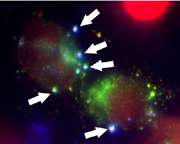Dr Siu-yuen CHAN (陳小圓)
BSc(Hons) The University of Hong Kong
MPhil The University of Hong Kong
PhD University of Cambridge

Associate Professor
Department of Paediatrics and Adolescent Medicine, School of Clinical Medicine,
The University of Hong Kong
Specialty
Developmental Biology
Genetics
| Contact | Email: Tel: Fax: |
(852) 22554485 (852) 28551523 Department of Paediatrics & Adolescent Medicine Room 115, 1/F, New Clinical Building 102 Pokfulam Road, Queen Mary Hospital, Hong Kong |
| Lab website |  |
Research ID Research
Development and Disease
My group is interested in understanding the genetic control of mammalian development and how abnormalities in this process lead to diseases. We have been using transgenic and ‘knockout’ mice to elucidate gene function. Our current focus is on the TSPYL family proteins. TSPYL proteins belong to the nucleosome assembly protein family with a putative role in the epigenetic control of gene expression. We have generated Tspyl2 knockout mice and demonstrated a role of TSPYL2 in cell cycle control. In addition, TSPYL2 controls gene expression in neurons.
I have a long standing interest in elucidating gene function. We have reported the functions of epidermal growth factor (EGF) and RET receptor tyrosine kinase. We have revealed a role of EGF in the hair growth cycle, spermatogenesis, bone growth and dopamine metabolism. Abnormal EGF or RET signalling results in cancer. We are now testing whether TSPYL family proteins also have a role during embryonic development and in cancer.
Donation to Programme: Development and disease, Department of Paediatrics & Adolescent Medicine |
|
Selected publications
| l | M. Cardano, M. Magni, R. Alfieri, S.Y. Chan, S. Sabbioneda, G. Buscemi & L. Zannini (2023) Sex specific regulation of TSPY-Like 2 in the DNA damage response of cancer cells. Cell Death & Disease, 14, 197. |
| l | T.Z.E. Kang, L. Zhu, D. Yang, D. Ding, X. Zhu, Y.C.E. Wan, J. Liu, S. Ramakrishnan, L.L. Chan, S.Y. Chan, X. Wang, H. Gan, J. Han, T. Ishibashi, Q. Li, K.M. Chan (2021) The elevated transcription of ADAM19 by the oncohistone H2BE76K contributes to oncogenic properties in breast cancer. J. Biol. Chem, 296, 100374. |
| l | L. Peng, E.H.W. Leung, J. So, P.H.S. Mak, C.L. Lee, H. Tan, K.F. Lee and S.Y. Chan (2020) TSPYL1 regulates steroidogenic gene expression and male fertility in mice. F&S Science, doi: https://doi.org/10.1016/j.xfss.2020.08.001. |
| l | C.H. Chong, Q. Li, P.H.S. Mak, C.C.P. Ng, E.H.W. Leung, V.H. Tan, A.K.W. Chan, G. McAlonan, S.Y. Chan (2019) Lrrc7 mutant mice model developmental emotional dysregulation that can be alleviated by mGluR5 allosteric modulation. Translational Psychiatry, 9,244. |
| l | M. Magni, G. Buscemi, L. Maita, L. Peng, S.Y. Chan, A. Montecucco, D. Delia and L. Zannini (2018) TSPYL2 is a novel regulator of SIRT1 and p300 activity in response to DNA damage. Cell Death and Differentiation doi: 10.1038/s41418-018-0168-6. |
| l | H. Liu, L. Peng, J. So, K.H. Tsang, C.H. Chong, P.H.S. Mak, K.M. Chan and S.Y. Chan (2018) TSPYL2 regulates the expression of EZH2 target genes in neurons. Molecular Neurobiology doi: 10.1007/s12035-018-1238-y. |
| l | Q. Li, S.Y. Chan, K.K. Wong, R. Wei, Y.O. Leung, A.Y. Ding, T.C. Hui, C. Cheung, S.E. Chua, P.C. Sham, E.X. Wu and G.M. McAlonan. (2016) TSPYL2 loss-of-function causes neurodevelopmental brain and behaviour abnormalities in mice. Behavior Genetics 46(4), 529-37. |
| l | K.H. Tsang, S.K. Lai, Q. Li, W.H. Yung, H. Liu, H.S. Mak, C.P. Ng, G. McAlonan, Y.S. Chan and S.Y. Chan (2014) The Nucleosome Assembly Protein TSPYL2 Regulates the Expression of NMDA Receptor Subunits GluN2A and GluN2B. Scientific Reports 4, 3654. |
| l | T. Eda, M. Mizuno, K. Araki, Y. Iwakura, H. Namba, H. Sotoyama, A. Kakita, H. Takahashi, H. Satoh, S.Y. Chan, H. Nawa (2013) Neurobehavioral deficits of epidermal growth factor-overexpressing transgenic mice: impact on dopamine metabolism. Neurosci. Lett., 28, 547:21-5. |
| l | A.S. Don-Salu-Hewage, S.Y. Chan, K.M. McAndrews, M.A. Chetram, M.R. Dawson, D.A. Bethea, C.V. Hinton (2013) Cysteine (C)-X-C Receptor 4 undergoes transportin 1-Dependent nuclear localization and remains functional at the nucleus of metastatic prostate cancer cells. PLOS One, 8(2), e57194. |
| l | K.P. Tao., S.W. Fong, Z. Lu, Y. P. Ching , K.W. Chan, S.Y. Chan (2011) TSPYL2 is important for G1 checkpoint maintenance upon DNA damage. PLoS One, 6(6), e21602. |
| l | Y. Liang, P. H. Chiu, K.Y. Yip and S.Y.Chan (2011) Subcellular localization of SUN2 is regulated by lamin A and rab5. PLoS One, 6(5), e20507. |
| l | R.H.K. Lee, W.L. Wong, C.H. Chan and S.Y. Chan (2006) Differential effects of glial cell line-derived neurotrophic factor and neurturin in RET/GFRα expressing cells. J. Neurosci. Res., 83, 80-90. |
| l | K.K.L. Mak and S.Y. Chan (2003) Epidermal growth factor as a biologic switch in the hair cycle.J. Biol. Chem., 278, 26120-26126. |
| l | D.C.W. Lee, K.W. Chan, S.Y. Chan (2002) RET receptor tyrosine kinase isoforms in kidney function and disease. Oncogene, 21, 5582-5592. |
| l | R.W.C. Wong, R.W.P. Kwan, P.H.S. Mak, K.K.L. Mak, M.H. Sham and S.Y. Chan (2000) Overexpression of epidermal growth factor induced hypospermatogenesis in transgenic mice. J. Biol. Chem., 275 (24), 18297-18301. |
| l | S.Y. Chan and R.W.C. Wong (2000) Expression of epidermal growth factor in transgenic mice causes growth retardation. J. Biol. Chem., 275 (49), 38693-38698. |
Teaching
1. MBBS: Genetics Workshop
2. MBBS: Problem Based Learning
3. MMedSc OBGY6600 Genetic Counselling Module 1: Principles of Genetic Counselling
Research supervisor: 5 Final year project students (2 BSc Bioinformatics, 1 BBiomedSc , 3 BSc), 20 MPhil students (19 graduated), 11 PhD students (10 graduated)
Examiner of 123 post-graduate students (29 as external, 94 as internal)

